 | Peter Blake, "On the Balcony", 1955-7 Peter Blake's oeuvre is sadly very small. His work usually combines different levels or modes of realism in the same work. In this painting, the children are larger, cartoonish, and flatly painted, serving as a ground, really, for the myriad magazine images, which are painted on, rather than being straight collage. The painting is named after the narrow black and white band in the middle of the painting which is an image of the royal family. |
| Archigram,"Seaside Bubbles",1966 Archigram was first a magazine, then an official group. They mined the architectural possibilities of the imaginary structures from pulp science fiction. This must have been anathema to the legions of uber-serious architecture students, who were very earnestly designing scores of drab boxes to honor the living memory of Meis van der Rohe. |  |
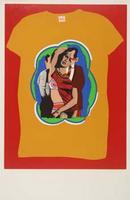 | Allen Jones, "Dream T-Shirt", 1964 An interesting framing device. |
| Malcolm Morley,"Messerschmitt with Spitfire", 2000 Morley started his career in the '60s as a photo-realist, and switched to a neo-expressionist style in the '80s. In the last decade or so, he's synthesized the free compositions of the expressionist work, with the clean approach of his early work, with good results. This is a wall-size painting from a series based on the die-cut papercraft airplanes which used to come on cereal boxes and the like. Morley, as a child, had an airplane crash into his bedroom, in his absence, during the Battle of Britain. The odd patterns on the planes are their because many pilots would give their planes custom paint jobs. |  |
 | R.B.Kitaj, "Autumn of Central Paris", 1972 This is an artist who really has a problem with self-editing. His career defining moment wasn't a painting at all, but was when he cited anti-semitism as the reason for all of the bad reviews of his London retrospective in the '70s. This was in poor taste and alienated a lot of people. Also, I find that his work slides off into neo-expressionist drivel after his early career. That said, I really like this painting. I think it makes great use of a cartoon syntax. It's about the final days of the philosopher Walter Benjamin, author of "Art in the Age of Mechanical Reproduction", who was killed fleeing the Nazis. |
| Pauline Boty, "Tom's Dream", 1963 Pauline Boty mixed large Mattise-cut-out shapes with more illustrative passages to good effect. She unfortunately died at the age of twenty-eight. |  |
 | Patrick Caulfield, "Portrait of Juan Gris", 1963 ... in the interest of weblog continuity. |
Wednesday, August 31, 2005
Brit pop, addenda
In this post, I'll be appending some artists of interest to the discussion of pop art below. Pop art's origins are in Britain, specifically with Richard Hamilton, Eduardo Paolozzi and the Independent Group. Unlike their American counter-parts, these Brit pop artists didn't have a critical figure like a Steinberg or Greenberg to co-opt or codify them. The work when taken together very much reflects the anarchic spirit of youth culture, and the rock and roll of the time. Robert Hughes, in his American Visions series, says that the difference between British and American pop art was that the British were responding to the American popular culture being piped over the sea as a distant oasis, full of possibilities and seperate from the stodgy, conformist society they lived in; whereas the Americans were making Pop art out of nausea or narciscism, as a reaction to Fifth Avenue.
Tuesday, August 30, 2005
Sunday, August 28, 2005
Juan Gris
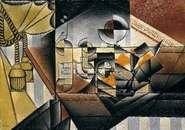
I went to an exhibit on Sunday with most of the collected works by Juan Gris at the Museo Nacional Centro de Arte Reina Sofia in Madrid. He is an artist that tends to play second fiddle in the history books to Picasso and Braque because he did not invent analytical cubism, but in my opinion he did it much better and took the movement to much higher levels. Throughout his work there is a good fusion of drawing, painting facture, and collage with mathematical systems and precision. Those of you fighting the interior battle between cold logic and emo-painter's-painting might find a look worthwhile. Unfortunately I had difficulty finding good image archives in cyberspace.
Juan Gris. Pinturas y dibujos 1910-1927
Saturday, August 27, 2005
Dehumanizing art

Alex has requested that I post more "bottom of the barrel" art, and I gleefully comply. This turtle, named Koopa, is forever doomed to muck about in acrylic paint for the edification of its owner. Each painting has a section with process photos, and, at the bottom, an illustration of how the product would look above your couch. Oh, happy day!
Link, via the dread Portal of Evil
5th grade RPGs & X-ray vision
In the summer of 1987, my parents decided to stay in Pennsylvania, much to my chagrin. I wanted to return to suburban Maryland. My family moved out of a large farm house with an expansive woods behind it, into a cramped row house in Carlisle proper, to await the purchase of a more permanent home. During the summer, my brothers and I were ferried back and forth to the community pool, and I was sent to Computer Camp at the near by Shippensburg University, where they taught Logo, and only Logo. My family also purchased a new computer, a Tandy 1000SX, to replace the TI/99-4a, which we'd owned for five years. I would spend ten to twelve hours a day, parked in front of the computer, mostly playing games, with the Oliver North hearings droning in the living room behind me. That summer my parents bought me two games, which in hindsight, have qualities essential to the computer RPG.
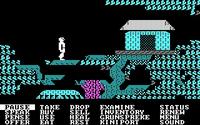 The first was entitled Below the Root, which was the story of a race of tree dwelling elves (hippies!) who were unknowingly menaced by a threat from the caverns beneath the roots of the trees that they built their homes in. The game was very unstructured with an immense and varied game world. This made it largely unwinnable, which would bother many gamers, but not myself. Each game session, though usually never making any progress in the prescribed "plot", was an adventure different from the last.
The first was entitled Below the Root, which was the story of a race of tree dwelling elves (hippies!) who were unknowingly menaced by a threat from the caverns beneath the roots of the trees that they built their homes in. The game was very unstructured with an immense and varied game world. This made it largely unwinnable, which would bother many gamers, but not myself. Each game session, though usually never making any progress in the prescribed "plot", was an adventure different from the last.
 The second game was Shōgun by Mastertronic. It was built around a simple social network simulation. The player was expected to befriend, murder, and subjugate his fellow game characters. This game took a while to get interesting, but the politics and tactics of a fully developed session were very exciting. After the player had accrued a number of followers, rival lords would begin sending their subjects to attack. Surviving required assigning one's followers to the appropriate offensive, defensive, and diplomatic tasks. This idea of social simulation as game play would be utilized later by video game auteurs like Peter Molyneux and Will Wright. Several months later I got Ultima 5, a masterpiece of a game, which had many of these qualities: varied characters and allegiances, and an expansive game world. Many other RPGs, like Bard's Tale and the SSI gold-box games, focused much-too-much on combat, levels, and loot.
The second game was Shōgun by Mastertronic. It was built around a simple social network simulation. The player was expected to befriend, murder, and subjugate his fellow game characters. This game took a while to get interesting, but the politics and tactics of a fully developed session were very exciting. After the player had accrued a number of followers, rival lords would begin sending their subjects to attack. Surviving required assigning one's followers to the appropriate offensive, defensive, and diplomatic tasks. This idea of social simulation as game play would be utilized later by video game auteurs like Peter Molyneux and Will Wright. Several months later I got Ultima 5, a masterpiece of a game, which had many of these qualities: varied characters and allegiances, and an expansive game world. Many other RPGs, like Bard's Tale and the SSI gold-box games, focused much-too-much on combat, levels, and loot.
Disharoon, Dale and Snyder, Zilpha. Below the Root. Telarium: Windham Classics, 1984. Based on the fantasy novels of Zilpha Snyder.
Lee, Steve. Shōgun. Mastertronic, 1987. Based on the book by James Clavell.
One of the skills that I'm going to need in architecture work is the ability to see how things are put together from cues on the surface. This manner of x-ray vision is quite similiar to the skills necessary to draw people well, that is, knowing the fundamentals of anatomy and drapery, and being able to see things from the inside out.

Gilbert Gorski,"Random Access Memory", 1989.
 The first was entitled Below the Root, which was the story of a race of tree dwelling elves (hippies!) who were unknowingly menaced by a threat from the caverns beneath the roots of the trees that they built their homes in. The game was very unstructured with an immense and varied game world. This made it largely unwinnable, which would bother many gamers, but not myself. Each game session, though usually never making any progress in the prescribed "plot", was an adventure different from the last.
The first was entitled Below the Root, which was the story of a race of tree dwelling elves (hippies!) who were unknowingly menaced by a threat from the caverns beneath the roots of the trees that they built their homes in. The game was very unstructured with an immense and varied game world. This made it largely unwinnable, which would bother many gamers, but not myself. Each game session, though usually never making any progress in the prescribed "plot", was an adventure different from the last. The second game was Shōgun by Mastertronic. It was built around a simple social network simulation. The player was expected to befriend, murder, and subjugate his fellow game characters. This game took a while to get interesting, but the politics and tactics of a fully developed session were very exciting. After the player had accrued a number of followers, rival lords would begin sending their subjects to attack. Surviving required assigning one's followers to the appropriate offensive, defensive, and diplomatic tasks. This idea of social simulation as game play would be utilized later by video game auteurs like Peter Molyneux and Will Wright. Several months later I got Ultima 5, a masterpiece of a game, which had many of these qualities: varied characters and allegiances, and an expansive game world. Many other RPGs, like Bard's Tale and the SSI gold-box games, focused much-too-much on combat, levels, and loot.
The second game was Shōgun by Mastertronic. It was built around a simple social network simulation. The player was expected to befriend, murder, and subjugate his fellow game characters. This game took a while to get interesting, but the politics and tactics of a fully developed session were very exciting. After the player had accrued a number of followers, rival lords would begin sending their subjects to attack. Surviving required assigning one's followers to the appropriate offensive, defensive, and diplomatic tasks. This idea of social simulation as game play would be utilized later by video game auteurs like Peter Molyneux and Will Wright. Several months later I got Ultima 5, a masterpiece of a game, which had many of these qualities: varied characters and allegiances, and an expansive game world. Many other RPGs, like Bard's Tale and the SSI gold-box games, focused much-too-much on combat, levels, and loot.Disharoon, Dale and Snyder, Zilpha. Below the Root. Telarium: Windham Classics, 1984. Based on the fantasy novels of Zilpha Snyder.
Lee, Steve. Shōgun. Mastertronic, 1987. Based on the book by James Clavell.
One of the skills that I'm going to need in architecture work is the ability to see how things are put together from cues on the surface. This manner of x-ray vision is quite similiar to the skills necessary to draw people well, that is, knowing the fundamentals of anatomy and drapery, and being able to see things from the inside out.

Gilbert Gorski,"Random Access Memory", 1989.
Wednesday, August 24, 2005
Hey kids, we're the barbarians at the gates!
"My work is an invitation to look elsewhere."-Robert Rauchenberg, drunk on top of a ladder, in the film Painters Painting.
An art critic for the Times of London has penned a piece declaring Pop art intolerably passé.
Short diatribe follows: I'm all for immersive experience and personal signifigance, who isn't? The fallacy here is that he's using Pop art as a strawman for the moneyed art world, caused by what he sees as corrupt, ignorant, and unworthy collectors. (The philistines!) Taking the inclination of critics to pigeon-hole in the name of analysis in stride; I think this is a prime example of our gallery-museum apparatus's inability to be honest about the boundaries between the studio, the gallery and society's art consumers. The idea that the capital-A of the art is diminished once money changes hands, or once someone without an MFA professes to liking it, is laughable. Sure, Warhol and his ilk will always be stuck in the sixties, and are currently being swapped between aging trophy wives like baseball cards, but the real message of Pop art is that everyone should be an artist.
Tuesday, August 23, 2005
BERLIN
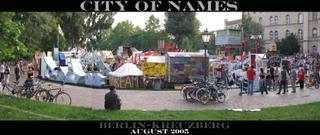

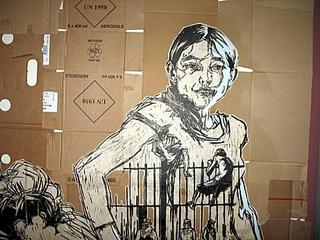
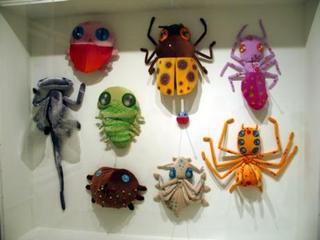

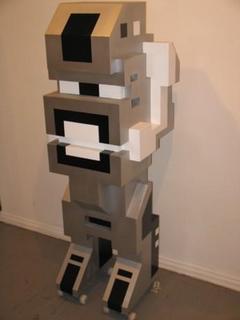
In an attempt to get me excited about my upcoming scouting trip to the former GDR (just in case the Spanish beuracrats deport me again). ASTROMEN! field agent and serious attention-deficit-disorder sufferer RY-GUY sent me these ecclectic photographs (among many others) taken at exhibitions he has been visiting there. For those of you who have not picked up an issue of ARTFORUM in the last few years, everyone in Berlin is apparantly a hip art kid these days.
(Page layout here makes my brain mushy . . . )
EDIT: Your page layout skills makes MY brain mushy! FIXED! -Alex
Smithsonian, 08-22-05
 | I drove down to D.C. today, to go to the Smithsonian. The great thing about the museums there is that they're completely free, unlike those in Manhattan. Also, everything is in one place, which is conducive to free-association. So it makes for a very cheap day, other than the small up-front fee of gas and a Metro card. I went down primarily to see the Visual Music exhibit at the Hirschhorn, which was different than I expected, but cool. I left Carlisle a bit late, so I only had three hours with the museums. I got through the Hirshhorn and the Museum of American History, and a few rooms of the National Gallery before they closed. |
| Giacomo Balla, Plastic Construction of Noise and Speed,1914-5 A lot of my thinking recently has been about the synthesis of sculpture and picture; like dioramas, friezes, cut-outs, holograms and pop-up books. Here's an example of such a synthesis, in a style which could be at home in a '50s Chrysler dealership or at a mall in the '80s. One thing I saw later in the day, which made me think back to this, and futurism, was that General Motors mounted a campaign in the '30s to promote a corporatized, technological society. The first was a caravan that travel town to town demonstrating science, this campaign was called "The Parade of Progress". The second campaign was a pavilion at the 1939 New York World's Fair entitled "Futurama". | 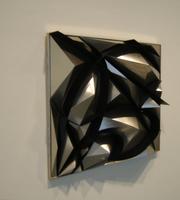 |
 | Red Grooms,Loft on 26th Street,1965-6. This is a diorama by a very eccentric artist I don't know nearly enough about. Oddly, he was a student of Hans Hofmann at one point. |
| I haven't noticed before how Thiebaud treats his lines. They're made up of very bright colors, sometimes with different hues striped beside one another. It's the large areas of matte, cake-icing consistency paint that he's known for, which define his sharp edges, which run up to and occlude all but thin multi-hued ribbons. He does this even with his figure paintings. |  |
 | A display of prothetic hands at the Museum of American History. |
| This is a replica of a 1950s CTA train and platform in an exhibit about the effects of transportation on society. Next door is an exhibit about the evolution of computers and communications, but it was closed for renovations. I was perturbed, because I was very much looking forward to visiting that technological graveyard. |  |
Monday, August 22, 2005
Into the breach, Program!

Darwinia, the closest anyone's probably ever going to get to a TRON real-time strategy game, is something I stumbled upon while searching the Internet(s) for free gaming goodness.
It is, unfortunately, not free. However, this amazingly cool game was self-published by an indy outfit called Introversion Software, so the 30$ you drop will be going strait into artist's pockets instead of down the hall to marketing for another fucking focus-group full of 12 year olds, gushing about how they want, no NEED, to be Ninjas. GIGANTIC ROBOT NINJAS!
A demo level is available, which I recommend, but you MUST read this play guide before starting or you will suffer instant and painful frustration, swelling, and burning.
It is, unfortunately, not free. However, this amazingly cool game was self-published by an indy outfit called Introversion Software, so the 30$ you drop will be going strait into artist's pockets instead of down the hall to marketing for another fucking focus-group full of 12 year olds, gushing about how they want, no NEED, to be Ninjas. GIGANTIC ROBOT NINJAS!
A demo level is available, which I recommend, but you MUST read this play guide before starting or you will suffer instant and painful frustration, swelling, and burning.
Violence: The Roleplaying Game of Egregious and Repulsive Bloodshed
Just in case all you geeks and kids out there were becoming too callous. Very amusing.
"no, we don’t have a fucking dodge skill. nobody dodges bullets except in john wu movies"
Finally, someone who openly defies "ninjafication."
Found this at Games * Design * Art * Culture via BoingBoing.
"no, we don’t have a fucking dodge skill. nobody dodges bullets except in john wu movies"
Finally, someone who openly defies "ninjafication."
Found this at Games * Design * Art * Culture via BoingBoing.
Lego renditions of contemporary art
A duo called the Little Artists is holding a show of Lego renditions of contemporary British art in Liverpool. I dunno, but the creepy guys who ran our Lego pirate battle are much more interesting than these twerps. Maybe if they spoofed some art that wasn't a spoof to begin with. Worth a peek, anyway, considering our Blockland endeavors.
Link to the Guardian article, via Artcyclopedia.
And now for something completely different.
Link to the Guardian article, via Artcyclopedia.
And now for something completely different.
Sunday, August 21, 2005
Julian Opie, lowest common denominator
An artist who I've been keeping an eye on made #2 on the Guardian's list of Britain's 10 worst artworks. The piece in question is Julian Opie's "paintings" for a Blur album cover, shown below. John Jones, Guardian art critic says: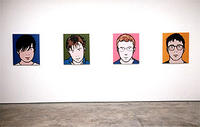
Anyway, Opie's art isn't uniformly bad. I'm interested in his work because he shares a few of the same sources as me: the paintings of Patrick Caulfield, and the interiors and sculptural work of Lichtenstein. (Not that my ideal work looks anything like this.) Opie's stuff works when it is a counterpoint to an actual environment, or, in his early work which referenced the video games of the early '90s, when it is an environment in itself. The key phrase in the Guardian critique is, "It's not anything that couldn't have been done on a computer." Dubuffet's art was engineered to elicit, "A child could do this!" This kind of work is the new Art Brut.
Link to Guardian article, via ArtsJournal.
Link to Julian Opie's website.

"Almost anything in the National Portrait Gallery is irritating, but this is particularly so because Opie's done such a smoothed out, contemporary, stylish painting without any real originality or feeling or emotion. It's not anything that couldn't have been done on a computer. I know it invites comparisons with Warhol and Richter, but with both of those there are great painterly touches and emotions, but not with Opie."Critiquing a lot of contemporary art, in a public forum like a newspaper, is next to impossible to do without sounding immensely out-of-it. This is because much of the art hanging in galleries around the world is designed to provoke specific responses. And when these complaints are expressed, the rest of us are supposed to snicker because the person taking offense obviously isn't in on the shtick. From my worm's eye view, lots of art world patter is constructed off of repetition of praise, put-downs and buzzwords.
Anyway, Opie's art isn't uniformly bad. I'm interested in his work because he shares a few of the same sources as me: the paintings of Patrick Caulfield, and the interiors and sculptural work of Lichtenstein. (Not that my ideal work looks anything like this.) Opie's stuff works when it is a counterpoint to an actual environment, or, in his early work which referenced the video games of the early '90s, when it is an environment in itself. The key phrase in the Guardian critique is, "It's not anything that couldn't have been done on a computer." Dubuffet's art was engineered to elicit, "A child could do this!" This kind of work is the new Art Brut.
 |  |
Link to Julian Opie's website.
Saturday, August 20, 2005
Pencil envy
 I highly recommend using a pencil extender. It will save you money. It will give you another range of motion to work with, though it is awkward at first. Because it weighs more, it gives more feedback. Which I suspect helps with muscle memory.
I highly recommend using a pencil extender. It will save you money. It will give you another range of motion to work with, though it is awkward at first. Because it weighs more, it gives more feedback. Which I suspect helps with muscle memory. In school, nearly all of the work that I was satisfied with was made in a very structured setting, like in figure drawing class. During the past two weeks I've made a point to draw with an egg-timer at least a half an hour a day. Not only does this help me feel much better about myself, but I've lost all of the neurotic trepidation that I had before. It makes sense to practice starting work, as well, because well over half of the decisions one makes on a drawing are evident in the first shapes. I plan on continuing this practice, though so far I've only managed four days a week. Someday I want to be able to say, "I haven't missed a day drawing in [X] years." I think where I went wrong during my last semester in school is that I got further and further away from my drawing practice. The following are pictures from that semester. If I could do it over I would make completely different work.
In school, nearly all of the work that I was satisfied with was made in a very structured setting, like in figure drawing class. During the past two weeks I've made a point to draw with an egg-timer at least a half an hour a day. Not only does this help me feel much better about myself, but I've lost all of the neurotic trepidation that I had before. It makes sense to practice starting work, as well, because well over half of the decisions one makes on a drawing are evident in the first shapes. I plan on continuing this practice, though so far I've only managed four days a week. Someday I want to be able to say, "I haven't missed a day drawing in [X] years." I think where I went wrong during my last semester in school is that I got further and further away from my drawing practice. The following are pictures from that semester. If I could do it over I would make completely different work. | 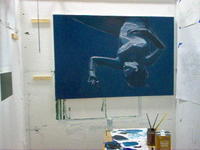 |
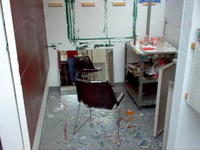 |  |
 |  |
 | 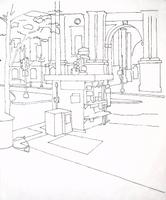 |
 Today I was in Harrisburg buying books for the Architectural Technology program that I start next week. I stopped by the State Museum to see the Art of the State exhibition. In it was a painting by a seventh floor 1995-6 Wolberg Hall resident, Joe Hu, who did his Master's work at PAFA and now lives in Philadelphia. The painting's entitled "Friday Night, Up All Night".
Today I was in Harrisburg buying books for the Architectural Technology program that I start next week. I stopped by the State Museum to see the Art of the State exhibition. In it was a painting by a seventh floor 1995-6 Wolberg Hall resident, Joe Hu, who did his Master's work at PAFA and now lives in Philadelphia. The painting's entitled "Friday Night, Up All Night".Link to Joe's website.
Thursday, August 18, 2005
Gone but not forgotten
Wednesday, August 17, 2005
"I read it on the Internet!"
The following was found in a thread spawned from a post over at Hullabaloo (it was penned by this guy). I thought it was spot on:
Speaking as someone living in a country (Japan) that, at one time, experienced a military dictatorship that presided over a 250-year period of modest economic growth, what amazes me is the mind bendingly wasteful incompetence of the Iraq adventure. The transparent deception with which the proceedings were kicked off was, and is, sick-making enough by itself; but what really astonishes is the childish abandon with which resources of all kinds have been squandered on this fool's gambit, as if pride and violence and knavishness and exceptionalism had some inherent value standing on their own. The United States is evidently not yet driven by a serious need for resources. There is apparently so much slack that both diplomacy and war can be treated as luxury consumption items. When the nation's survival comes to depend on these skills, well, good luck.
Robert Adams
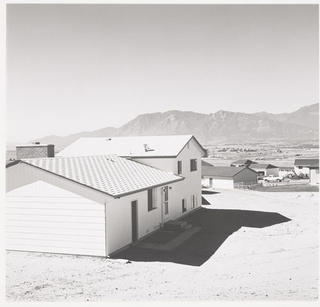 The degeneration of quality in urban space through cheap structures and mass marketing is an idea that I have been grappling with for some time. I mostly grew up in the near suburbs of Seattle but never felt interested nor entirely comfortable with the atmosphere and often sought out the less antiseptic spaces of the Pike Place Market, Capitol Hill, or the International District in search of noodles and comic books. This idea grew in my mind as I experienced the strip mall phenomenom to a greater degree in places like Los Angeles or Chicago, but it was not until my visits last year to the newly booming regions of Las Vegas and Pheonix that I was truly shocked and somewhat horrified to a degree well expressed in the article at the end of my last post. Even my native downtown Seattle or the legendary mid-town Manhattan have largely succumbed to urban space being little more than a giant mall. Living in Europe I have been able to compare the varying ideas about town planning from other countries. For example, Spain seems delighted by the idea of a growing suburban car culture with easy to access fast food stops; while Holland appears to be entirely insulated against the phenomenon.
The degeneration of quality in urban space through cheap structures and mass marketing is an idea that I have been grappling with for some time. I mostly grew up in the near suburbs of Seattle but never felt interested nor entirely comfortable with the atmosphere and often sought out the less antiseptic spaces of the Pike Place Market, Capitol Hill, or the International District in search of noodles and comic books. This idea grew in my mind as I experienced the strip mall phenomenom to a greater degree in places like Los Angeles or Chicago, but it was not until my visits last year to the newly booming regions of Las Vegas and Pheonix that I was truly shocked and somewhat horrified to a degree well expressed in the article at the end of my last post. Even my native downtown Seattle or the legendary mid-town Manhattan have largely succumbed to urban space being little more than a giant mall. Living in Europe I have been able to compare the varying ideas about town planning from other countries. For example, Spain seems delighted by the idea of a growing suburban car culture with easy to access fast food stops; while Holland appears to be entirely insulated against the phenomenon.This is one photographer that goes straight to the heart of suburbia as it was just beginning to flourish in the wild west of the United States.
Robert Adams
Born in
From a Yale Art Gallery announcement.
A large archive of images can be found here.
A Spin Through Cyberspace
In case anyone was currently lacking, here are some doses of heavy irony.
This project reminds me that if I am ever going to be a hip contemporary artist I need to work on my "high concept" and clever pranks. At least they seem like they are having fun:
Ministry of Reshelving puts 1984 in its proper place
Growing up in the Reagan/Bush Sr. presidential block, my earliest political interests were awakened with such shady end of the cold war antics as when ketchup became the only vegetable in my school lunch to help pay for the Star-Wars-Soviet-Zapping-Lasers, and Panama was suddenly invaded with little explanation. Putting things through the perspective of the current White House outlook a history lesson in Bush Sr. CIA trained pragmatism while attempting world domination sure seems like a breath of fresh air. That this article is being pulled from the archives gives the previous link a certain poignancy:
Reasons Not to Invade Iraq, by George Bush Sr.
Here is the latest long winded rant by my favourite angry editorialist. This is a topic artists (particularly with photography) have been documenting in places like Los Angeles and Chicago for decades. I will see if I can find some good images:
One Happy Big-Box Wasteland
This project reminds me that if I am ever going to be a hip contemporary artist I need to work on my "high concept" and clever pranks. At least they seem like they are having fun:
Ministry of Reshelving puts 1984 in its proper place
Growing up in the Reagan/Bush Sr. presidential block, my earliest political interests were awakened with such shady end of the cold war antics as when ketchup became the only vegetable in my school lunch to help pay for the Star-Wars-Soviet-Zapping-Lasers, and Panama was suddenly invaded with little explanation. Putting things through the perspective of the current White House outlook a history lesson in Bush Sr. CIA trained pragmatism while attempting world domination sure seems like a breath of fresh air. That this article is being pulled from the archives gives the previous link a certain poignancy:
Reasons Not to Invade Iraq, by George Bush Sr.
Here is the latest long winded rant by my favourite angry editorialist. This is a topic artists (particularly with photography) have been documenting in places like Los Angeles and Chicago for decades. I will see if I can find some good images:
One Happy Big-Box Wasteland
Tuesday, August 16, 2005
Walken 2008
You know, the political landscape is fairly bleak when a thing like this fills me with a few seconds of fleeting hope.
I mean, why not? Instead of campaign flyers he could just hand out free King of New York DVDs. I for one wouldn't mind having a President who's a talented artist and who's probably also read Communion. It would certainly be a step up from the current model.
Edit: I'm obsessively editing and then re-editing my posts. I blame my Father for teaching me about the evil concept of re-writing. Curse you Father! Now I'm dammed to a life of endless fiddling with sentence rhythm and vocabulary!
I mean, why not? Instead of campaign flyers he could just hand out free King of New York DVDs. I for one wouldn't mind having a President who's a talented artist and who's probably also read Communion. It would certainly be a step up from the current model.
Edit: I'm obsessively editing and then re-editing my posts. I blame my Father for teaching me about the evil concept of re-writing. Curse you Father! Now I'm dammed to a life of endless fiddling with sentence rhythm and vocabulary!
Paolozzi & Ballard in conversation
I have a book of interviews and writings by Eduardo Paolozzi, the grand-daddy of Pop art, checked-out of the Temple Library on my new alumni card. In it is a fascinating conversation between the artist and J.G. Ballard, a British science fiction writer whose most famous book is Crash, and whose auto-biography is the source for Spielberg's Empire of the Sun. Anytime fine art and science fiction are in the same room I pay very strict attention. I'm going to post a few excerpts from the conversation, which took place in 1971, prior to an opening of Paolozzi's work at the Tate, London. I apologize for the length of this post, but I had a hard time pearing down the interview to just this handful of quotes.
1, 2, 3, 4, 5, 6, 7, 8.
Spencer, Robin. ed. Eduardo Paolozzi: Writings and Interviews. NYC: Oxford University Press, 2000. 198-207.
First Published in: Studio International, 193 (Oct. 1971), 138-43.
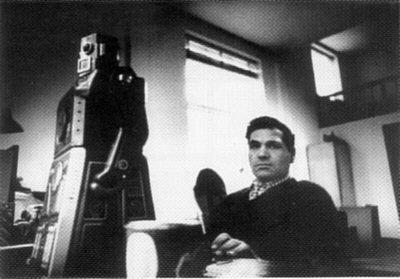
Ballard: "[T]he world of the mind, is largely ruled by the laws of fiction, by one's dreams, visions, impressions and so on, and the whole idea of the unconscious as a narrative stage. Surrealism molds the two worlds together, remakes the external world of reality in terms of the internal world of fantasy and fiction. Now what has happened, and one reason why there are no Surrealist painters in the truest sense of the term today, is that this position has been reversed. It's the external world which is now ... the paramount realm of fantasy. And it's the internal world of the mind which is the one node of reality that most of us have. The fiction is all out there. You can't overlay your own fiction on top of that. You've got to use, I think, a much more analytic technique than the synthetic technique of the Surrealists. Eduardo does this in his graphics. He's approaching the subject-matter of the present-day exactly like the scientist on safari.... The environment is filled with more fiction and fantasy than any of us can singly isolate. It's no longer necessary for us individually to dream. It completely cuts the ground from under all the tenets of classical Surrealism."
Ballard: "Eduardo said the other day, that violence is probably going to play the same role in the '70s and '80s that sex played in the '50s and '60s... Although our central nervous systems have been handed to us on a plate by millions of years of evolution, have been trained to respond to violence at the level of finger-tip and nerve-ending, in fact now our only experience with violence is in the head, in terms of our imagination, the last place where we were designed to deal with violence. We have absolutely no biological training to deal with violence in imaginative terms... We sit passively in cinemas watching movies like The Wild Bunch where violence is just a style. Just over a year ago I put on an exhibition of crashed cars, what I called 'new sculpture', at the New Arts Lab. And I had three cars brought to the gallery. It was very easy to mount the show because the technology of moving cars is highly developed... And I had an opening party at the gallery. I'd never seen 100 people get so drunk so quickly. Now this had something to do with the cars on display. I also had a topless girl interviewing people on closed circuit TV so that people could see themselves being interviewed around crashed cars by this topless girl. This was clearly too much. I was the only sober person there. Wine was poured over the crashed cars, glasses were broken, the topless girl was nearly raped in the back seat of the Pontiac by some self-aggrandizing character. The show went on for a month. In that time [the cars] came up against massive hostility of every kind. The cars were attacked, the windows ripped off. Those windows that weren't already broken were smashed. One of the cars was upended, another splashed with white paint."
Paolozzi: "The public's dilemma comes from the fact that they're still looking for ... objects in the fine-art tradition, and it's this kind of object the public usually gets. Most of the American Pop painters fit absolutely into the tradition of, say, post-Corot painting. A Lichtenstein is no more radical than, say, a Manet... How can any Pop painter be said to have had [the impact of Manet], to have advanced beyond that? As far as I'm concerned there's a slight disillusionment with America now; the American dream is over. I think the Olivetti [etchings] take a cool look at a special kind of pornography, the pornography of human values. And in a way, [the work is] forcing people to look at a state they accept, like having monkeys work with computers, and also perhaps suggesting a kind of corporate image, the faceless man: That whole world of Fortune magazine, the whole business language of the American Stock Exchange, the faceless white collar worker turning into a mechanical man. It's not just technology, it's looking with as fresh an eye as possible at the whole realm of human experience."The etchings the artist refers to were commissioned by the British Olivetti Limited company that same year, and were entitled Cloud Atomic Laboratory. All 8 prints can be viewed at the Tate's website:
1, 2, 3, 4, 5, 6, 7, 8.
Spencer, Robin. ed. Eduardo Paolozzi: Writings and Interviews. NYC: Oxford University Press, 2000. 198-207.
First Published in: Studio International, 193 (Oct. 1971), 138-43.

Monday, August 15, 2005
Found Photos

This gentleman (no, not the underage drinker to the left) searches file sharing networks for inadvertently available personal photography. Check it out.
Edit: Hmm, looks like there's also a print magazine (how quaint) devoted to this topic called FOUND. Their website has some cool-cool images. Also, it looks like they're on a promo tour to pimp a XXX version of their mag. OH-MY!
Man, it looks like they have more than just pictures! Wow, just wow. Remember Astromen: NO USING OTHER PEOPLE'S PIPES!!
Sunday, August 14, 2005
Screenshots of the Blockland pirate ship!


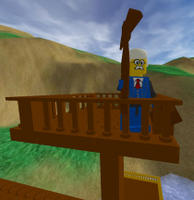

Ahrr! At daybreak today we found our boat marooned in this wadin' pool. It was decided the accountant was the offendin' party and he was sent to sleep in davey jones's locker.
EDIT: So I added better screenshots, which were NOT taken on a computer cobbled together from surplus Russian missile parts. I was also able to locate an image of the fiendish accountant, as well as the hole he built in the bottom of the boat. My advice: Stick to accounting!
Amazingly, I was also able to locate rare images of both Pete and Jason's computers for our readers. The Astromen: On the Cutting Edge! -Alex
Saturday, August 13, 2005
A few Blockland screenshots

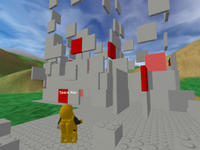
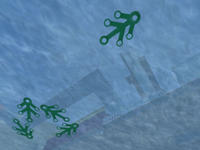 Blockland today was amazing fun! The Astromen created a digital fortress, a UFO for self-help cultists, and a fearsome pirate ship.
Blockland today was amazing fun! The Astromen created a digital fortress, a UFO for self-help cultists, and a fearsome pirate ship.This was also our first time using a Teamspeak server during play, and the effect was totally bizarre. (You know the future? Guess what: you're living in it right now!)
We also played a few rounds of a Polish game called Soldat, which is chaos on a stick.
Just remember: It's hot outside, so just stay inside and play video-games all day with your friends!
Subscribe to:
Posts (Atom)


